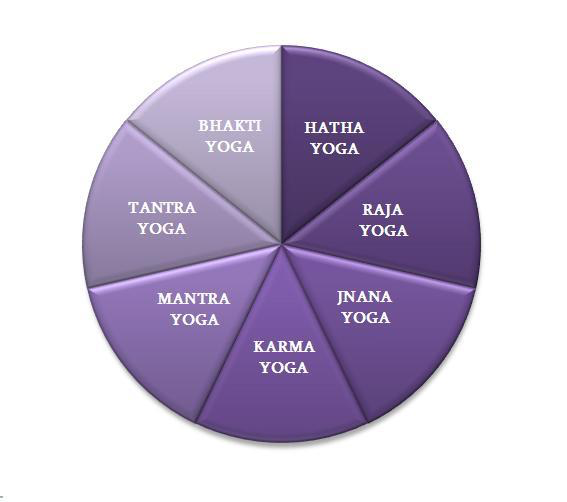Wheel of Yoga – 7 paths of Yoga
Keeping in mind that Yoga can be described as both the path and also the goal of union or oneness that is reached by walking this journey, one might ask what the path itself looks like. From the yogic perspective, this does not have to be the same for everyone. In fact, originally there were four different paths of yoga, which have been split further into seven paths.
These different paths are also sometimes referred to as “The Wheel of Yoga”:
1 – Raja Yoga– The royal path of physical and mental control
The Yoga of Raja Yoga is described by Patanjali in the Yoga Sutras and is practiced by following the Eight Limbs, also called Ashtanga Yoga. Through the practice of the eight limbs, the student learns to control his/her mind and his/her body, becomes absorbed in meditation and eventually enters into the state of Samadhi, which is a super conscious state, in which the goal of Yoga, the union of Atman (individual soul) and Brahman (universal soul), is realized.
2 – Hatha Yoga – Yoga of focused physical effort
It is said that in the system that recognizes 7 paths of Yoga, Hatha Yogaevolved out of Raja Yoga. Hatha Yogafocuses on the physical part of yoga: the practice of asanas (body postures) and pranayama (breath control), which are the third and the fifth limb of Ashtanga Yoga described by Patanjali. Hatha comes from the two syllables Ha– Sun and Tha– Moon and represents the union of these two opposite aspects and all the characteristics that are associated with them. For example, Ha– Sun, is connected to activity, heat, daytime, warmth and Pingala Nadi (the energy channel to the right side of the spine, the main energy channel), and Tha– Moon is connected to passivity, rest, the cold, nighttime and Ida Nadi (the energy channel to the left side of the spine).
3 – Bhakti Yoga – The path of the heart, devotion and unconditional love
In Bhakti Yoga the experience of union comes from completely surrendering one’s ego or one’s self-will to the Higher Self or God. It is the path of the heart. The goal of Yoga is realized through unconditional love, devotion and passion. Bhakti Yoga is described in the Bhagavad Gita (one of the main basic yogic texts), and Arjuna, who completely devotes himself to his teacher Krishna, embodies someone who attains the goal of Yoga through the practice of Bhakti. Chanting, mantras and rituals are common practices in Bhakti Yoga.
4 – Karma Yoga– The Yoga of Selfless Service & Action
This path of yoga talks to people who like to be of service, to the doctors and teachers in us.
Also Karma Yoga is described in depth in the Bhagavad Gita and relates directly to Bhakti Yoga. Karma Yogais about letting go of all the outcomes of one’s action and being of service purely for the sake of benefitting and helping another, no matter what the personal gains might be. A Karma Yogiacts without thought of what he might get out of it. This ties in with Bhakti, because also in Karma Yogathe aim is to completely surrender one’s ego to the divine and completely give of oneself. The experience of unconditional love can be said to be a result of selfless action.
5 – Jnana Yoga – The Yoga of knowledge and wisdom
This path of yoga is for the intellectual, who likes to study and at times needs proof through scientific experiments.
Just as Bhakti and Karma Yoga, also Jnana Yoga is described in the Bhagavad Gita. Jnana Yoga is concerned with wisdom in the form of inquiring into one’s own nature. This self-inquiry is also a big part of what the Upanishads teach. Through study of the self, the student will eventually come to the realization, that seeing oneself as separate from others and the Higher Self is a deception. The Sadhaka (spiritual aspirant) comes to know, that he is but a small part of all that around him and thus realizes his union or oneness. The Bhagavad Gita tells us that Jnana Yoga ought to be combined with selfless service and devotion to God, the Higher Self, as without it, the self-inquiry would remain intellectual knowledge only.
6 – Tantra Yoga – Yoga of rituals (Kundalini Shakti)
This path of Yoga is described as involving rituals and unlike the other paths is not based on the vedantic philosophy. Instead the basis here is the tantric philosophy. Where Vedanta sees Yoga as the union of Atman (individual soul) with Brahman (universal soul), Tantra sees Yoga as the union between Shiva (the male) and Shakti (the female). In the philosophy of Tantra, Shiva is understood as the male aspect and is said to be seated in the area of the Ajna or Third-Eye Chakra (physiologically where the pineal gland is located). Shakti is the female energy and is said to live at the base of the spine, where the Kundalini originates from. Tantra Yoga focuses on aspects that awaken the Kundalini. Kundalini is depicted as a snake rising (Prana energy floating upward) from the very base of the spine to the Third-Eye Chakra, thus uniting Shakti with Shiva– union of the opposites, the male and female aspects that we all carry within ourselves.
7 – Mantra Yoga – Yoga of sound and repetition
The word Mantrais derived from manas (mind) and trayati (liberation) and deals with the liberation of the human mind. A short phrase is uttered either audibly or mentally in order to focus and concentrate more. Most of the traditional mantras possess a particular meaning and vibration. So each mantrahas got a different spiritual influence on the consciousness of the practitioner. At times a mala is used – stringed bead necklaces with 108 beads – to help with japa-mantra (repeated mantras) to take track of how often they are chanted.

